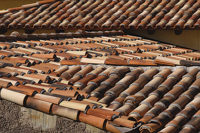
The ridge vent is usually rolled into place at
the highest peak of a sloped roof, over an opening that allows warm, humid air
to escape the attic. Photos courtesy of Benjamin Obdyke Incorporated.
With changes to the IRC and IBC attic ventilation codes coming in 2012 that will improve the performance of attics installed with a ridge vent, the time is right to review the basics of the ridge vent. Veteran roofing and building professionals know that ridge vent positively contributes significantly to the home’s energy efficiency, and also extends the life of the roof and housing structure itself. Professionals new to the industry, though, could probably benefit from a quick tutorial.
How Ridge Vents Work
A ridge vent is a type of exhaust vent installed end-to-end at the peak of a sloped roof, allowing warm, moist air to escape at an opening at the highest point of the roof. When put into place, it is shingled over to make it virtually invisible from below. The ridge vent has been in continuous use for many years, more so after the introduction of the industry’s first ridge vent on a roll, which helped dramatically speed installation.It works on the basis of several principles. Adequate under-eave soffit ventilation for intake is coupled with the ridge vent to produce a pathway for a continuous airflow along the underside of the roof deck. Airflow is maintained two ways. First, warmer air in the attic space naturally rises and exits out of the ridge vent opening, while pulling in cooler air from the soffit vents. Second, positive airflow across the ridge of the house creates a “Venturi effect” - or a negative pressure - which pulls air out of the ridge vent and brings in air from the soffits. No matter if it’s calm or windy, the entire attic is vented by a constant flow of cooler, drier outside air.
Although a slot is cut along the roof peak to allow for warm air to exhaust, the design of the ridge vent which covers it keeps wind, rain, snow, even insects, out of the attic. All ridge vent products contain breathable weather barriers or external or internal baffles to prevent the possibility of leakage that may occur with other venting devices, such as some traditional mushroom, pot or gable end vents. Reputable ridge vent manufacturers subject their products to independent testing and certification that includes hurricane-force winds, 8-inch-per-hour rain, and simulated snow conditions. It’s essential that installers consult product technical bulletins and installation instructions available from manufacturers to ensure proper weather protection.

Once the ridge vent has been nailed into place,
roofers shingle over the vent, making it virtually invisible from the ground
below.
Why Ventilation Is Necessary
More than any other part of the house, the roof is subject to extremely high heat, both on and under the roof deck. When attics are left unvented, hot and humid air will build up, penetrating the home’s living space. The area below will be warmed, causing increased demand on air conditioners and increased utility costs. Often less obvious in the winter, occupant-generated moisture from household activities such as bathing, showering, and cooking, will rise and settle in the attic. When wet, insulation loses its effectiveness and allows valuable heat to escape through the attic.Soaked insulation can also cultivate mold or mildew or lead to stained or crumbled ceilings. Even worse, unvented moisture can accumulate on the rafters and decking of the roof structure, leading to rot and structural decay. In every season, a ridge vent system lets the hot and/or humid air escape and has been proven to lower air conditioning costs in the summer and heating costs in the winter.
It’s also important to remember that proper ventilation guidelines must be followed to validate most shingle manufacturers’ warranties.
Another major concern to homeowners and roofers alike, especially in snow-belt and mountain areas, is ice damming. Ice dams are created on unvented attics when melting snow from the warmer, higher part of the roof freezes on the lower, cooler part of the roof, placing roof, walls, ceilings, siding, gutters and downspouts at risk from structural and staining damage. A ridge vent system helps reduce the possibility of ice damming since it delivers a constant flow of air that circulates under the entire roof, keeping it close to the same temperature throughout. Proper ventilation helps eliminate warmer upper areas and cooler lower areas that create the thaw-re-freeze cycle.

Ridge vent is available in a variety of
materials, as well as in rolled and sectional forms. Shown is an externally
baffled shingle-over ridge vent with sine-wave shaped internal and external
baffled to prevent weather and insect infiltration.
Identifying a Home's Ridge Vent Needs
Many homes are improperly or inadequately ventilated, even when some venting devices are installed. Here are some signs of improper ventilation:• Damp insulation.
• Unnaturally dark or discolored decking.
• Dark streaks on roof boards around nails.
• Orange resin beads on rafters signaling sweating wood.
• Moisture on roof board and rafters.
• Crumbling, curled roof shingles.
In some cases, major structural repairs may be needed before addressing the need for a proper attic ventilation system. In less drastic situations, the problems may be solved simply by installing additional ventilation. To determine ventilation needs, the first step is to measure the square footage of the attic floor and use the number to calculate how much net free area (NFA) the ventilation must provide. The NFA is the open area that exists for air to pass through. In the attic, it is the approximate clear opening of the ventilator through which air may move. The key to effective venting is to balance the NFA of the soffit and the ridge vent. Ideally the NFA of the soffits should be equal or greater than that of the ridge vent. Some manufacturers’ websites include a vent calculator for contractors and builders to determine the proper NFA requirements.
In 2010, the IRC and IBC code language requiring approximately an equal ratio of balance of air movement between ridge vent and soffit vent met approval during Final Action Hearings in Texas. Previously, the code allowed up to 80 percent of the attic ventilation to be installed at the upper portion, or peak, of the attic. This historically led to unbalanced systems that could cause moisture problems. With the code change, at least 40 percent - and not more than 50 percent - of the ventilation should be installed in the upper portion. The Roofing Assembly Ventilation Coalition, of which Benjamin Obdyke is an active member, is responsible for proposing and getting the change through the approval process. The code changes take effect in 2012.Another change successfully initiated by the Roofing Assembly Ventilation Coalition is a requirement for a vapor barrier on the warm-in-winter side of ceilings in climate zones that are generally north of the Mason-Dixon Line. This will improve moisture performance within ventilated attic spaces.
A Ridge Vent for All Applications
Leading manufacturers offer a wide selection of rolled, sectional, and externally baffled ridge vent products that improve airflow and ventilation between attic and roof. Most products offer shingle-over low-profile designs that make the ridge vent invisible from the ground, as well as a compression-resistant design that is easy to install. Some are designed to be manually nailed into place, while others are nail gun-able. There are also products for a wide variety of roof styles and pitches, as well as premium and builder grades. Among the products available is the industry’s lightest-weight ridge vent on a roll, which delivers quick, labor-saving installation, as well as rolled products that incorporate exterior baffling, combining the best of rolled and sectional products.Manufacturers continue to work together to educate contractors, specifiers, builders, architects, engineers, building code officials, and the public about the benefits of proper steep-slope roof ventilation. It can be a key design element in achieving cost-effective, sustainable, energy-efficient building design and construction.


Report Abusive Comment